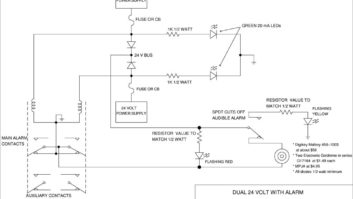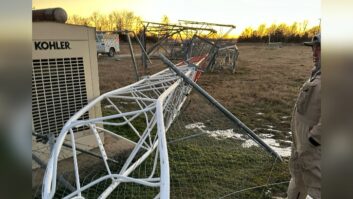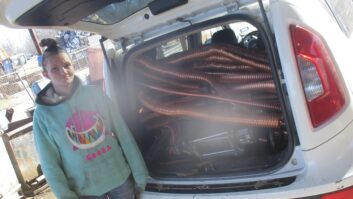
Fig. 1: A bullet pierced a leg of a tower; the damage was noticed by a tower rigger performing a quarterly inspection. Our broadcast towers often are built in remote places, and autumn brings a special kind of vandal to such sites, one who is armed and thinks your tower, tower light and coax line are fair game.
Shooting damage can be a nuisance or it can be catastrophic. Such incidents also pose a threat to an engineer.
“No Hunting” signs are respected by responsible hunters, and you should use them. But what about after damage has occurred? Unless a bullet pierced your transmission line or antenna and caused an immediate, dramatic leak in air pressure (or worse), you may not even know your facility has been hit.
That’s why a quarterly, even yearly, inspection by a rigger is so important. Yes, it’s expensive. Treat it like insurance: What problems will the rigger find that could have escalated into a terrible disaster?
Fig. 1 gives us an example. This “guy with a rifle” (I won’t honor him with the title of hunter) had amazing aim. But pity the tower rigger whose line is clamped to the tower and who snapped the photo. This kind of damage is scary!
In addition to the hole through the tower leg, your tower inspector can find coax nicks or holes, broken support straps or hangers, and cracked or broken tower light lenses. As this engineer did, make sure the climber brings along a camera. Documentation of this sort opens the door for a great discussion with your GM (not to mention giving you great visuals to share with fellow engineers in a future Workbench column — anonymity is assured).
The tower climber may also find things that need attention, such as rusted line clamps. It’s easy to see from the pictures that this tower needs some help. But help costs money, and as long as the station is on the air, such problems may be set aside by upper management.
Pictures also serve to protect you, the engineer, against false claims that you’re “not doing your job.” In today’s climate of lawsuits, take the time to type up the findings, submit them to the GM or owner, and keep a copy.
Your tower inspection should not only include the tower but the guys and anchor points. Visit the anchor points, walking the site with the rigger, asking for his professional opinion of things that could be improved or upgraded. With many stations preparing budgets this time of year, a new coat of paint on the tower may trump new sales computers!
* * *
Paul Sagi, an engineer in Malaysia and longtime Workbench contributor, wonders how many engineers are still using Ampex open-reel tape machines. In today’s digital age, my guess is not many. However, I have visited stations where the production room holds at least one vintage reel-to-reel, just in case.
Paul has some experience repairing these machines, and offers a tip to readers. Remember the venerable Ampex 600B reel-to-reel? Great machines, but after years of use, the clutches sometimes seize up. The cause is the clutch-bearing grease hardening.
Ampex used eddy current clutches in these machines; the service manual warns that the machines need special jigs/fixtures, and can’t be repaired in the field. At issue is a 1/10,000-to-1/20,000-inch clearance rotor-to-stator.
Paul dismantled the clutches anyway, including the bearing dust covers, used solvent to remove the old grease from the bearings, added fresh lithium grease and reassembled. Sure enough, there was no clearance. The rotors were frozen.
As he thought about the problem, Paul realized the magnetic field inside the clutch would be symmetric and centered. The small gap inside the clutch would present an intense field, and thus the field would exert a strong force on the rotor to self-center it.
Paul’s procedure is to assemble the clutch but leave the screws a bit loose, so the clutch parts have a little freedom to move. Then apply the usual 110 VDC supply to the clutch coil, which will align the clutch. You may prod the sections a bit with your fingers, in case you have the screws a little too tight. Now, confirm free rotation, and gradually tighten the screws, all the time confirming free rotation. Remove the voltage source, and confirm free rotation; and you’re done.
No jigs or fixtures; and the process does not take long. You can figure five minutes alignment per clutch.
It’s odd that the engineers at Ampex never thought of using the magnetic field of the clutch coil to self-align the clutch.
* * *
Allen Alleo has a fun website for engineers who like to experiment and build circuits. You’ll find a variety of power supplies and motor controllers at www.bangkoktoshop.com.
Contribute to Workbench. You’ll help your fellow engineers, and qualify for SBE recertification credit. Send Workbench tips to [email protected]. Fax to (603) 472-4944.
Author John Bisset has spent 44 years in the broadcasting industry and is still learning. He handles West Coast sales for the Telos Alliance. He is SBE Certified and is a past recipient of the SBE’s Educator of the Year Award.












